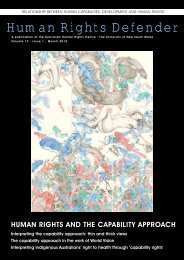'Photojournalism as a line of defence in war' by Brigit Morris
'Photojournalism as a line of defence in war' by Brigit Morris
'Photojournalism as a line of defence in war' by Brigit Morris
Create successful ePaper yourself
Turn your PDF publications into a flip-book with our unique Google optimized e-Paper software.
Stephen Dupont, Brothers Reza and Husse<strong>in</strong> shoot<strong>in</strong>g up hero<strong>in</strong> beh<strong>in</strong>d Maiwan Avenue, Old City, Kabul, Afghanistan 2006. Courtesy <strong>of</strong> the artist.Like all mediums, photographs can be manipulated and even misused for avariety <strong>of</strong> agend<strong>as</strong>.around responsibility, historical truths, and the value <strong>of</strong> collectivememory-mak<strong>in</strong>g. The photos confront our <strong>as</strong>sumptions about the ability<strong>of</strong> ord<strong>in</strong>ary people to commit unspeakable acts. Many <strong>of</strong> the imagesportray execution pits where soldiers are posed <strong>in</strong> elevated positions atthe edge <strong>of</strong> kill<strong>in</strong>g sites. Accord<strong>in</strong>g to critic Bernd Huppauf, this distance<strong>of</strong>fered the k<strong>in</strong>d <strong>of</strong> ‘spatial separation’ 2 which buffers ord<strong>in</strong>ary men fromthe realities <strong>of</strong> their actions.Humanis<strong>in</strong>g suffer<strong>in</strong>gCultural signifiers like film, art and music <strong>of</strong>ten act <strong>as</strong> catalysts forchange. They <strong>in</strong>spire and <strong>in</strong>form their audiences. In times <strong>of</strong> war, viewerreactions are <strong>of</strong>ten shaped <strong>by</strong> cl<strong>in</strong>ical reports and statistics-ladenarticles. Photographs can make conflicts more tangible to those ata distance, and thus humanise the suffer<strong>in</strong>g <strong>of</strong> others. Without them,carnage and destruction can be un-imag<strong>in</strong>able. The absence <strong>of</strong>images makes it difficult to share experiences with others. In this way,photographers have multiple roles – historians, dramatists, artists andeven humanitarians.Australian-born photographer, Stephen Dupont, is a strik<strong>in</strong>g example<strong>of</strong> this multi-faceted role. Throughout his career, Dupont h<strong>as</strong> produceda haunt<strong>in</strong>gly beautiful body <strong>of</strong> work, focus<strong>in</strong>g on the fragile existence<strong>of</strong> humanity <strong>in</strong> times <strong>of</strong> conflict. Dupont h<strong>as</strong> documented conflictand the human condition <strong>in</strong> Papua New Gu<strong>in</strong>ea, Sri Lanka, E<strong>as</strong>t Timor,Iraq, and more recently, Afghanistan. Born <strong>in</strong> 1967, Dupont h<strong>as</strong> had anotable career receiv<strong>in</strong>g <strong>in</strong>ternational acclaim for his work and <strong>in</strong> theprocess w<strong>in</strong>n<strong>in</strong>g several notable prizes. These have <strong>in</strong>cluded a RobertCapa Gold Medal citation from the Overse<strong>as</strong> Press Club <strong>of</strong> America;a Bayeux War Correspondent’s Prize; and first places <strong>in</strong> the World PressPhoto. Pictures <strong>of</strong> the Year International, an Australian Walkley Award,and Leica/CCP Documentary Award. In 2007 he w<strong>as</strong> the recipient <strong>of</strong>the W. Eugene Smith Grant for Humanistic Photography for his work onAfghanistan. In 2010, he received the Gardner Fellowship at HarvardUniversity’s Peabody Museum <strong>of</strong> Archaeology and Ethnology.Controversially, <strong>in</strong> 2005 Dupont rele<strong>as</strong>ed photographs <strong>of</strong> US troopsburn<strong>in</strong>g the bodies <strong>of</strong> Taliban fighters, who had died <strong>in</strong> the course<strong>of</strong> conflict <strong>in</strong> Afghanistan. The photos were taken while Dupont w<strong>as</strong>embedded with a platton <strong>of</strong> U.S. mar<strong>in</strong>es, the 173rd Airborne Division,<strong>in</strong> Southern Afghanistan. ‘Taliban Burn<strong>in</strong>g’ is an eerily beautiful rem<strong>in</strong>derHuman Rights Defender : 14 Photojournalism <strong>as</strong> a L<strong>in</strong>e <strong>of</strong> Defence <strong>in</strong> War



